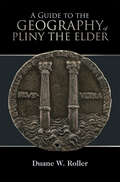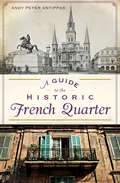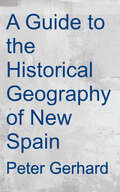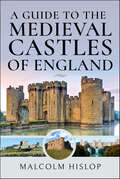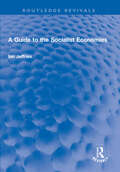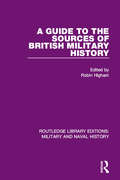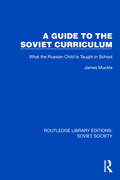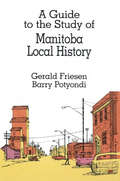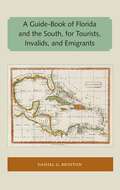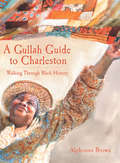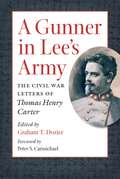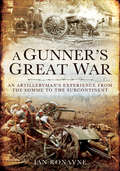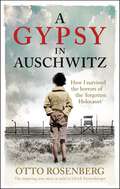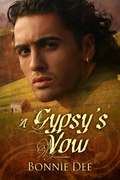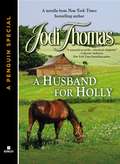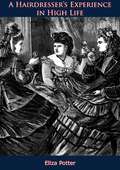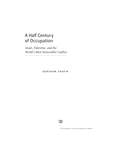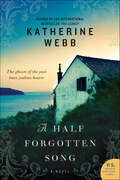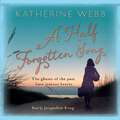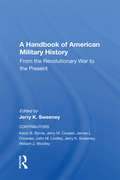- Table View
- List View
A Guide to the Geography of Pliny the Elder
by Duane W. RollerThis is the first thorough English commentary on the geographical books of Pliny the Elder, written in the AD 70s. Pliny's account is the longest in Latin, and represents the geographical knowledge of that era, when the Roman Empire was the dominant force in the Mediterranean world. The work serves both cultural and ideological functions: much of it is topographical, but it also demonstrates the political need to express a geographical basis for the importance of the Roman state. In five books, Pliny covers the entire world as it was known in his era and includes some of the first information on the extremities of the inhabited region, including Scandinavia and the Baltic, eastern Asia, and sub-Saharan Africa. The commentary provides a detailed analysis of all the points Pliny raises: his sources, toponyms, and understanding of the place of the earth in the cosmos.
A Guide to the Historic French Quarter (History And Guide Ser.)
by Andy Peter AntippasFrom Bourbon Street to Pirate&’s Alley and beyond—a local historian takes you on a walking tour of the historic French Quarter in New Orleans. Walking through the French Quarter can overwhelm the senses—and the imagination. The experience is much more meaningful with knowledge of the area&’s colorful history. For instance, the infamous 1890 &“separate but equal&” legal doctrine justifying racial segregation was upheld by the Louisiana Supreme Court at the Cabildo on Jackson Square. In the mid-twentieth century, a young Lee Harvey Oswald called Exchange Alley home. One of New Orleans&’s favorite cocktails—the sazerac—would not exist if Antoine Peychaud had not served his legendary bitters with cognac from his famous apothecary at 437 Royal. Local author Andy Peter Antippas presents a walking history of the Vieux Carre, one alley, corner and street at a time.
A Guide to the Historical Geography of New Spain (Cambridge Latin American Studies #Series Number 14)
by Alan Knight Peter GerhardA basic reference on Mexican colonial history, examining the minor administrative divisions constituting the government of New Spain (now central and southern New Mexico) as they were just before the introduction of the intendancy system in 1786. Most of the Guide 's sources are unpublished, but this revised edition incorporates the results of published studies, based on archival and field work, that correct errors and elaborate on themes discussed in the 1992 edition (Cambridge). Annotation copyright Book News, Inc. Portland, Or.
A Guide to the Medieval Castles of England
by Malcolm HislopThis is a well illustrated expert guide to the castles of England, providing concise accounts of what remains to be seen at each site. Spread across the medieval kingdom of England in a network of often formidable strongholds, castles, like cathedrals, are defining landmarks of their age, dominating their settings, in many cases even to this day. By representing an essential aspect of our history and heritage, the interpretation of which is constantly being revised, they demonstrate the value of Malcolm Hislop’s compact, authoritative and well illustrated new guide to English castles. The gazetteer includes an astonishing variety of types, sizes and designs. Individual entries bring out the salient points of interest including historical context, building history and architectural character. The defensive and domestic purposes of these remarkable buildings are explained, as is the way in which their layout and role developed over the course of hundreds of years, from the predominantly earth and timber fortresses of the Normans to the complex stone castles of the later Middle Ages, many of which can be visited today. Hislop’s experience as an archaeologist specializing in medieval buildings, castles in particular, as well as his eye for structural detail, ensure that his guide is a necessary handbook for readers who are keen on medieval history and warfare, and for visitors who are looking for an accessible introduction to these monumental relics of England’s military past.
A Guide to the Socialist Economies: A Guide (Routledge Revivals)
by Ian JeffriesFirst published in 1990, A Guide to the Socialist Economies explores the evolution of a variety of economic systems in the socialist world and highlights major problems facing fourteen countries – Albania, Bulgaria, China, Cuba, Czechoslovakia, the GDR, Hungary, North Korea, Mongolia, Poland, Romania, the Soviet Union, Vietnam and Yugoslavia –against a background of continuous change, characterized by such events as the Berlin blockade, the Korean war, the Hungarian revolution and the invasion of Czechoslovakia. The traditional Soviet economic model is studied in detail as the basic system adopted by or imposed upon all of these countries. A separate chapter is devoted to foreign trade in general and Comecon in particular, while each of the country studies deals with the political and economic background, economic reforms (including industry, agriculture, the financial system and foreign trade and capital) and the private sector. The book provides information on the economic institutions of all the individual countries which is invaluable if the various courses of reform each country has engaged upon are to be understood. Historical material supplements contemporary information in a work which is to be an essential reference for anyone engaged in a study of, or trade with, the socialist countries.
A Guide to the Sources of British Military History (Routledge Library Editions: Military and Naval History #25)
by Robin HighamDesigned to fill an overlooked gap, this book, originally published in 1972, provides a single unified introduction to bibliographical sources of British military history. Moreover it includes guidance in a number of fields in which no similar source is available at all, giving information on how to obtain acess to special collections and private archives, and links military history, especially during peacetime, with the development of science and technology.
A Guide to the Soviet Curriculum: What the Russian Child is Taught in School (Routledge Library Editions: Soviet Society)
by James MuckleA Guide to the Soviet Curriculum (1988) surveys the syllabuses for schoolchildren in the Soviet education system following the reforms of 1984. Every subject in the common timetable is covered, and teaching methods, hopes for the future and continuing controversies are discussed. All this is set in the broader context of curriculum philosophy and of the social and moral purposes of Soviet education; the implicit or ‘hidden’ curriculum is also considered.
A Guide to the Study of Manitoba Local History
by Gerald Friesen Barry PotyondiLocal history buffs, students, teachers, and armchair historians will find a wealth of information and practical advice in this guide to the study of local history. The authors explore some of the most fruitful areas of research in such themes as the environment, population, transportation and communication, agriculture, politics, social and family life. In five appendices they provide more detailed information for the determined researcher. Specific advice is given on compiling a community archive or data base, and on publishing a local history. An extensive bibliography and a guide to local archives complete the book.
A Guide-Book of Florida and the South, for Tourists, Invalids, and Emigrants: For Tourists, Invalids And Emigrants, With A Map Of The St. John River (classic Reprint) (Florida and the Caribbean Open Books Series)
by Daniel G. BrintonThe books in the Florida and the Caribbean Open Books Series demonstrate the University Press of Florida’s long history of publishing Latin American and Caribbean studies titles that connect in and through Florida, highlighting the connections between the Sunshine State and its neighboring islands. Books in this series show how early explorers found and settled Florida and the Caribbean. They tell the tales of early pioneers, both foreign and domestic. They examine topics critical to the area such as travel, migration, economic opportunity, and tourism. They look at the growth of Florida and the Caribbean and the attendant pressures on the environment, culture, urban development, and the movement of peoples, both forced and voluntary. The Florida and the Caribbean Open Books Series gathers the rich data available in these architectural, archaeological, cultural, and historical works, as well as the travelogues and naturalists’ sketches of the area in prior to the twentieth century, making it accessible for scholars and the general public alike. The Florida and the Caribbean Open Books Series is made possible through a grant from the National Endowment for the Humanities and the Andrew W. Mellon Foundation, under the Humanities Open Books program.
A Guided Tour of the Collected Works of C. G. Jung
by Robert H. HopckeThe writings of C. G. Jung himself are the best place to read about all his main ideas--but where to start, when Jung's Collected Works run to more than eighteen volumes? Robert H. Hopcke's guide to Jung's voluminous writings shows exactly the best place to begin for getting a handle on each of Jung's key concepts and ideas--from archetypal symbols to analytical psychology to UFOs. Each chapter explains one of Jung's principal concerns, then directs the reader where to read about it in depth in the Collected Works. Each chapter includes a list of secondary sources to approach for further study--which the author has updated for this edition to include books published in the ten years since the Guided Tour's first appearance.
A Gullah Guide to Charleston: Walking Through Black History (History & Guide)
by Alphonso BrownAn expert in Gullah culture introduces the rich history of black Charlestonians through a series of local walking tours plus a sightseeing drive. The Gullah people of the Lowcountry South are famous for their cuisine, Creole language, and exquisite crafts—yet there is so much more to this unique culture than most people realize. Alphonso Brown, the owner and operator of Gullah Tours, Inc., guides readers through the history and lore of this storied people in A Gullah Guide to Charlestown. With this volume guiding the way, you can visit Denmark Vesey's home, Catfish Row, the Old Slave Mart and the Market; learn about the sweetgrass basket makers, the Aiken-Rhett House slave quarters, black slave owners and blacksmith Philip Simmons. Brown's distinctive narration, combined with detailed maps and vibrant descriptions in native Gullah, make this an authentic and enjoyable way to experience the Holy City.
A Gunner in Lee's Army
by Peter S. Carmichael Graham DozierIn May 1861, Virginian Thomas Henry Carter (1831-1908) raised an artillery battery and joined the Confederate army. Over the next four years, he rose steadily in rank from captain to colonel, placing him among the senior artillerists in Robert E. Lee's Army of Northern Virginia. During the war, Carter wrote more than 100 revealing letters to his wife, Susan, about his service. His interactions with prominent officers--including Lee, Jubal A. Early, John B. Gordon, Robert E. Rodes, and others--come to life in Carter's astute comments about their conduct and personalities. Combining insightful observations on military operations, particularly of the Battles of Antietam and Spotsylvania Court House and the 1864 Shenandoah Valley Campaign, with revealing notes on the home front and the debate over the impressment and arming of slaves, Carter's letters are particularly interesting because his writing is not overly burdened by the rhetoric of the southern ruling class.Here, Graham Dozier offers the definitive edition of Carter's letters, meticulously transcribed and carefully annotated. This impressive collection provides a wealth of Carter's unvarnished opinions of the people and events that shaped his wartime experience, shedding new light on Lee's army and Confederate life in Virginia.
A Gunner's Great War: An Artilleryman's Experience from the Somme to the Subcontinent
by Ian RonayneIf the First World War had not happened when it did, Channel Islander Clarence Ahier would almost certainly have led a mostly unremarkable life. But it did, and in October 1915, aged just 23-years-old, Clarence left his home and volunteered to join the British Army. He would spend the next two and half years serving as an artillery man on the Western Front.Now this in itself is not remarkable—millions of other young men did the same thing. But Clarence Ahier did do something remarkable, and it was something to set him out from almost all his contemporaries. From the very beginning of his time at the front, he wrote a graphic and moving account of his experiences of war.Clarences ultimate plans for his meticulously written journal are unknown. But having lain unnoticed for years, it was recently discovered in a collection of dusty ephemera handed to a local history society.The complete journal consists of around 25,000 words, with a focus on Clarences experience during the Battle of the Somme, in the fighting around Ypres, and, after he was wounded for the second time, the journey to India and his time there as a member of the garrison. This will be supported by additional explanatory text.
A Gypsy In Auschwitz: How I Survived the Horrors of the ‘Forgotten Holocaust’
by Otto RosenbergOtto Rosenberg is 9 and living in Berlin, poor but happy, when his family are first detained. All around them, Sinti and Roma families are being torn from their homes by Nazis , leaving behind schools, jobs, friends, and businesses to live in forced encampments outside the city. One by one, families are broken up, adults and children disappear or are 'sent East'.Otto arrives in Auschwitz aged 15 and is later transferred to Buechenwald and Bergen-Belsen. He works, scrounges food whenever he can, witnesses and suffers horrific violence and is driven close to death by illness more than once. Unbelievably, he also joins an armed revolt of prisoners who, facing the SS and certain death, refuse to back down. Somehow, through luck, sheer human will to live, or both, he survives.The stories of Sinti and Roma suffering in Nazi Germany are all too often lost or untold. In this haunting account, Otto shares his story with a remarkable simplicity. Deeply moving, A Gypsy in Auschwitz is the incredible story of how a young Sinti boy miraculously survived the unimaginable darkness of the Holocaust.
A Gypsy In Auschwitz: How I Survived the Horrors of the ‘Forgotten Holocaust’
by Otto RosenbergOtto Rosenberg is 9 and living in Berlin, poor but happy, when his family are first detained. All around them, Sinti and Roma families are being torn from their homes by Nazis , leaving behind schools, jobs, friends, and businesses to live in forced encampments outside the city. One by one, families are broken up, adults and children disappear or are 'sent East'.Otto arrives in Auschwitz aged 15 and is later transferred to Buechenwald and Bergen-Belsen. He works, scrounges food whenever he can, witnesses and suffers horrific violence and is driven close to death by illness more than once. Unbelievably, he also joins an armed revolt of prisoners who, facing the SS and certain death, refuse to back down. Somehow, through luck, sheer human will to live, or both, he survives.The stories of Sinti and Roma suffering in Nazi Germany are all too often lost or untold. In this haunting account, Otto shares his story with a remarkable simplicity. Deeply moving, A Gypsy in Auschwitz is the incredible story of how a young Sinti boy miraculously survived the unimaginable darkness of the Holocaust.
A Gypsy's Vow
by Bonnie DeeA sensible marriage to a titled land-owner, or run away with the charming stranger who stirs feelings in her she never knew existed? Bess has a difficult decision to make. The wrong choice could destroy her chance for future happiness.A proper, level-headed woman. A handsome, wandering rogue.Sparks fly between them, but does the innkeeper's daughter dare leave behind all that's familiar to run away with a gypsy?After managing her drunken father's inn for most of her adult life, Bess is presented with an offer of marriage from a member of the local gentry. She should be thrilled at the proposed match with a man so far above her station, but knows Lord Wallace is more interested in the income from her successful business than he is in her.One day while shopping in the market, she meets a charming stranger who shakes up her world. She's unprepared for the onslaught of powerful feelings Alexi rouses in her as he woos her with passionate intensity. Now Bess must decide what she truly wants from life and how she chooses to live her future.
A HUSBAND FOR HOLLY: A novella from New York Times bestselling author Jodi Thomas
by Jodi ThomasAn unexpected love warms a woman's heart in this enchanting Christmas romance from "masterful storyteller"* Jodi Thomas... Holly, a beautiful Texas tomboy, gets more than she bargained for under the mistletoe after her godfathers decide to find her a husband. Praise for Jodi Thomas and her novels: "[Thomas] grabs your attention on the first page [and] captures your heart." --*Catherine Anderson "Exactly the kind of heart-wrenching, emotional story one has come to expect from Jodi Thomas." --Debbie Macomber, #1 New York Times bestselling author "Thomas sketches a slow, sweet surrender." --Publishers Weekly Includes a preview of Jodi's heartwarming new novel, Just Down the Road, available April 2012! Previously published in A Country Christmas.
A Hairdresser's Experience in High Life
by Eliza PotterPotter was a freeborn black woman who, as a hairdresser, was in a unique position to hear about, receive confidences from, and observe wealthy white women—and she recorded it all in a revelatory book that delighted Cincinnati's gossip columnists at the time. But more important is Potter's portrait of herself as a wage-earning woman, proud of her work, who earned high pay and accumulated quite a bit of money as one of the nation's earliest "beauticians" at a time when most black women worked at the bottom of the socioeconomic ladder. Because her work offered insights into the private lives of elite white women, Potter carved out a literary space that featured a black working woman at the center, rather than at the margins, of the era's transformations in gender, race, and class structure.-Print ed.
A Half Century of Occupation: Israel, Palestine, and the World's Most Intractable Conflict
by Gershon ShafirThe Israel-Palestine conflict is one of the world’s most polarizing confrontations. Its current phase, Israel’s “temporary” occupation of the West Bank, Gaza, and East Jerusalem, turned a half century old in June 2017. In these timely and provocative essays, Gershon Shafir asks three questions—What is the occupation, why has it lasted so long, and how has it transformed the Israeli-Palestinian conflict? His cogent answers illuminate how we got here, what here is, and where we are likely to go. Shafir expertly demonstrates that at its fiftieth year, the occupation is riven with paradoxes, legal inconsistencies, and conflicting interests that weaken the occupiers’ hold and leave the occupation itself vulnerable to challenge.
A Half Forgotten Song: A Novel
by Katherine WebbIn Half Forgotten Song, fourteen-year-old Mitzy Hatcher’s lonely life on the wild Dorset coast is changed forever when renowned artist Charles Aubrey arrives to summer there with his exotic mistress and daughters. Mitzy develops a bond with the Aubrey household, gradually becoming Charles's muse. Over the next three summers, a powerful love is kindled in her that grows from childish infatuation to something far more complex… Years later, a young man in an art gallery looks at a hastily drawn portrait and wonders at its intensity. The questions he asks lead him to a Dorset village and to the truth about those fevered summers in the 1930s. With Sunday Times bestselling novel Half Forgotten Song, Katherine Webb spins a historical tale of long kept secrets and obsessive love that fans of Kate Morton and Susanna Kearsley are sure to love.
A Half Forgotten Song: a powerful tale of the dark side of love, and the shocking truths that dwell there
by Katherine WebbFrom the bestselling author of The Legacy comes a powerful dual narrative, set between now and the 1930s, exploring the dark heart of obsessive love. For fans of Tracy Rees, Jenny Ashcroft and Rosanna Ley1937In a village on the Dorset coast, fourteen-year-old Mitzy Hatcher has had a wild and lonely upbringing - until the arrival of renowned artist Charles Aubrey, his exotic mistress and their daughters, changes everything. Over the next three summers, Mitzy glimpses a future she had never imagined, and a powerful love is kindled in her. A love that grows from innocence to obsession; from childish infatuation to something far more complex.Years later, a young man in an art gallery looks at a hastily drawn portrait and wonders at the intensity of it. The questions he asks lead him to a Dorset village and to the truth about those fevered summers in the 1930s...A Half Forgotten Song is an absorbing and intoxicating mystery around a love that takes hold and won't let go.Your favourite authors love Katherine Webb's novels: 'An enormously talented writer' Santa Montefiore 'Webb has a true gift for uncovering the mysteries of the human heart and exploring the truth of love' Kate Williams 'Katherine Webb's writing is beautiful' Elizabeth Fremantle 'A truly gifted writer of historical fiction' Lucinda Riley 'Katherine's writing is rich, vivid and evocative' Iona Grey
A Half Forgotten Song: a powerful tale of the dark side of love, and the shocking truths that dwell there
by Katherine WebbFrom the bestselling author of The Legacy comes a powerful dual narrative, set between now and the 1930s, exploring the dark heart of obsessive love. For fans of Tracy Rees, Jenny Ashcroft and Rosanna Ley1937In a village on the Dorset coast, fourteen-year-old Mitzy Hatcher has had a wild and lonely upbringing - until the arrival of renowned artist Charles Aubrey, his exotic mistress and their daughters, changes everything. Over the next three summers, Mitzy glimpses a future she had never imagined, and a powerful love is kindled in her. A love that grows from innocence to obsession; from childish infatuation to something far more complex.Years later, a young man in an art gallery looks at a hastily drawn portrait and wonders at the intensity of it. The questions he asks lead him to a Dorset village and to the truth about those fevered summers in the 1930s...A Half Forgotten Song is an absorbing and intoxicating mystery around a love that takes hold and won't let go.Your favourite authors love Katherine Webb's novels: 'An enormously talented writer' Santa Montefiore 'Webb has a true gift for uncovering the mysteries of the human heart and exploring the truth of love' Kate Williams 'Katherine Webb's writing is beautiful' Elizabeth Fremantle 'A truly gifted writer of historical fiction' Lucinda Riley 'Katherine's writing is rich, vivid and evocative' Iona Grey
A Half Forgotten Song: a powerful tale of the dark side of love, and the shocking truths that dwell there
by Katherine Webb1937. In a village on the Dorset coast, fourteen-year-old Mitzy Hatcher has endured a wild and lonely upbringing - until the arrival of renowned artist Charles Aubrey, his exotic mistress and their daughters, changes everything. Over the next three summers, Mitzy sees a future she had never thought possible, and a powerful love is kindled in her. A love that grows from innocence to obsession; from childish infatuation to something far more complex.Years later, a young man in an art gallery looks at a hastily drawn portrait and wonders at the intensity of it. The questions he asks lead him to a Dorset village and to the truth about those fevered summers in the 1930s . . .Read by Jacqueline King(p) 2012 Orion Publishing Group
A Half-Century of Greatness: The Creative Imagination of Europe, 1848-1884
by Frederic EwenChoice Outstanding Academic Title for 2008A Half-Century of Greatness paints a vivid and dramatic picture of the creative thought of mid- to late nineteenth century Europe and the influence of the unsuccessful revolutions of 1848. It reveals often unexpected links between novelists, poets, and philosophers from England, Germany, Austria, Hungary, Russia, and Ukraine—especially Dickens, Carlyle, Mill, the Brontës, and George Eliot; Hegel, Strauss, Feuerbach, Marx, Engels, Wagner, and several German poets; the Hungarian poet Sándor Petöfi; Gogol, Dostoevsky, Bakunin, and Herzen in Russia, and the great Ukrainian poet Shevchenko. Ewen goes on to trace the transition from Romanticism to Victorianism, or what he calls “the Victorian compromise”—the ascendancy of the middle class.The book was reconstructed and edited by Dr. Jeffrey Wollock from Ewen’s final manuscript. It includes the author's own reference citations throughout, a reconstructed bibliography, and an updated “further reading” list.This is Ewen’s last work, the long-lost companion to his Heroic Imagination. Together, these books present a panorama of the social, political, and artistic aspects of European Romanticism, especially foreshadowing and complementing recent work on the relation of Marxism to romanticism. Anyone interested in what Lukacs called “Romantic anticapitalism,”; who appreciates such books as Marshall Berman's Adventures in Marxism or E.P. Thompson's The Romantics (1997), will find Ewen’s work a welcome addition.
A Handbook Of American Military History: From The Revolutionary War To The Present
by Jerry SweeneyThis unique reference work covers the military history of the United States from the Revolution to the Gulf War. The Handbook of American Military History is comprehensive, easy to use, and supplies essential information on the social, technological, political, tactical, and strategic developments that have affected the evolution of the U.S.
